The Future of QR Codes: Trends and Projections for 2025
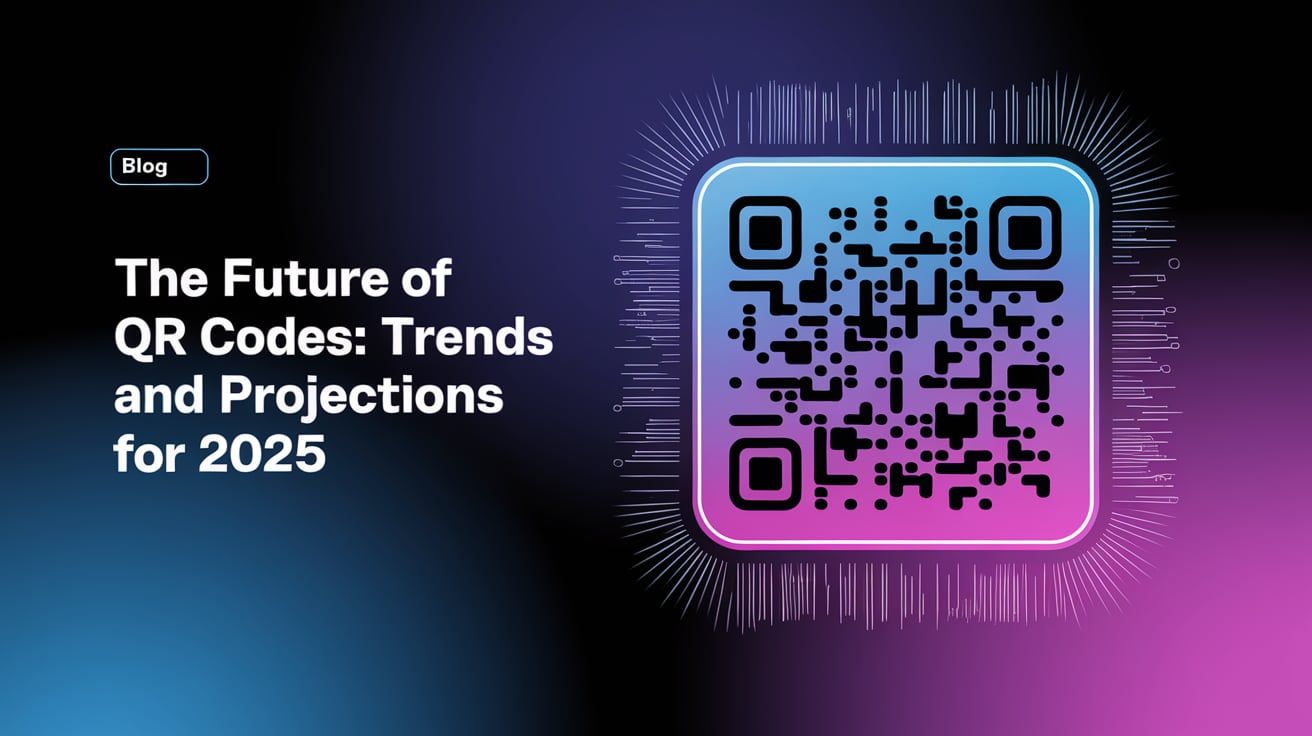

QR codes, those little square patterns we've begun to see almost everywhere, have become an integral part of today's digital world. Leveraging smartphone technology, QR codes act as an instant link between the physical and digital worlds, enabling quick and convenient dissemination of information.
Invented in 1994 for tracking parts in automotive manufacturing, QR codes now serve a plethora of purposes across industries, from providing product details in retail shops, enabling fast and contactless payment methods, to even displaying menus in restaurants.
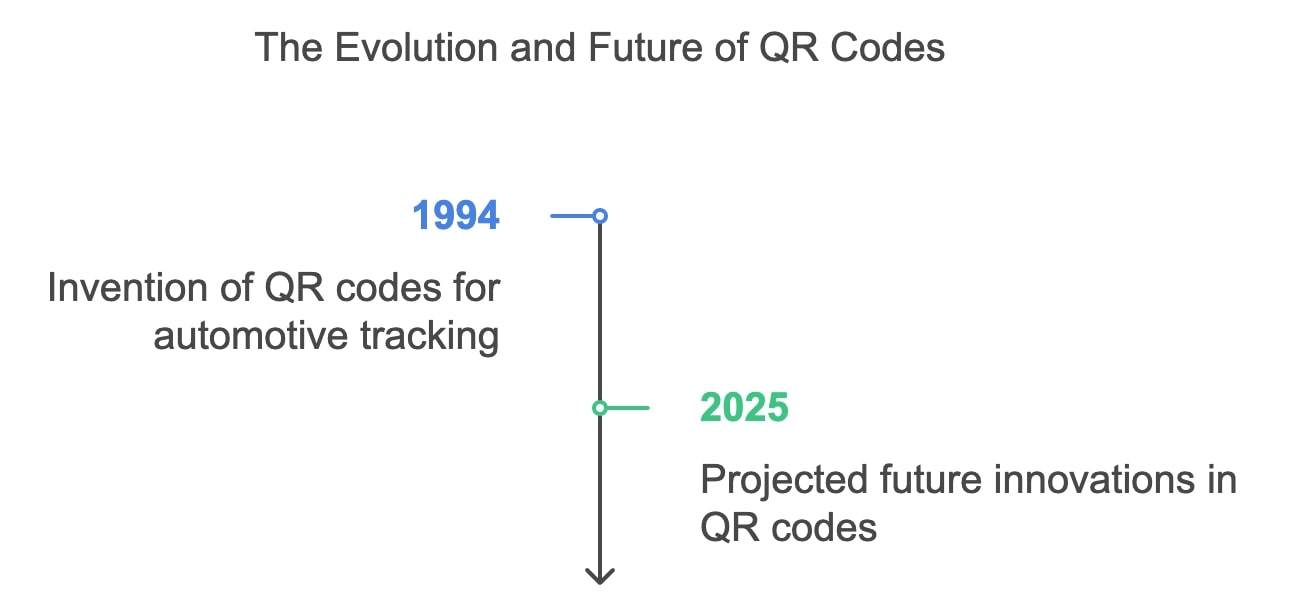
Since the inception of QR codes, they've evolved continuously, turning into a powerful tool boosted further by the global pandemic. Globally, QR code adoption has seen exponential growth over the past few years.
As we look forward, QR codes promise to bring even more innovation and utility. This article aims to provide a comprehensive overview of the future of QR codes, backing up these projections with empirical data and looking at the latest trends and predictions for the year 2025.
In my experience as a seasoned digital marketing specialist with extensive knowledge in QR code technologies, I've seen firsthand how these versatile tools can transform business strategies. Let's dive into the challenges and opportunities they present.
Year-on-Year Rise in QR Code Usage
The influx of digitalization and technological advancements in recent years has led to an exponential increase in QR code usage worldwide. This rise, which saw an unprecedented surge during the COVID-19 pandemic, continues to show momentum.
Global Increase in QR Code Usage
From aiding vehicle tracking in manufacturing to becoming a crucial component in marketing strategies for various industries, the journey of QR codes has been remarkable. In the wake of the pandemic, QR codes have found increased relevance as businesses across the globe sought contactless and effective modes of interaction with customers.
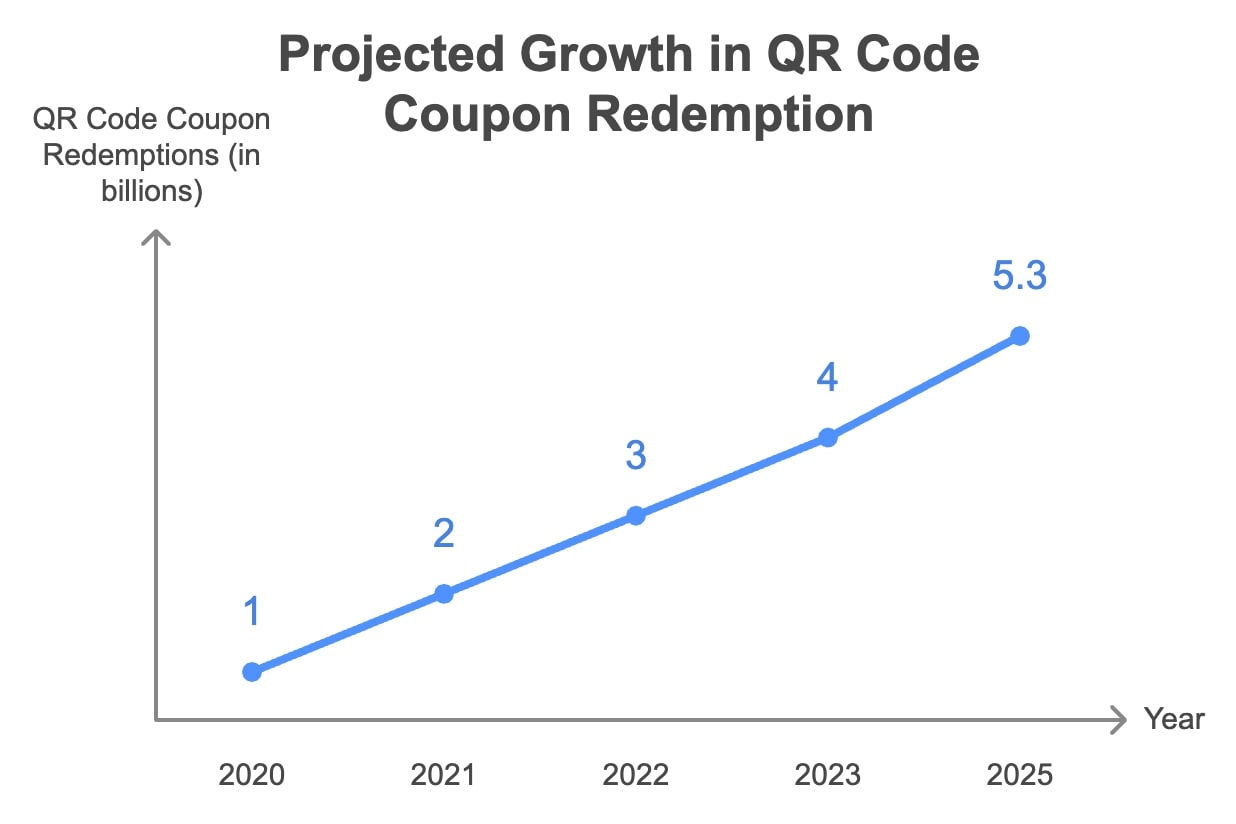
Given their ease of use and versatility, QR codes have proven to be an extremely user-friendly digital tool that connects online and offline channels. Data insight reflects an escalating growth trend in QR code usage, with an astonishing prediction that by 2025, QR code coupon redemption is set to surge to 5.3 billion.
📊 Stats Alert: The number of consumers in the United States who scan a QR code with their smartphone is expected to grow by million between 2022 and 2025.
Effects of the COVID-19 Pandemic
The COVID-19 pandemic has played a pivotal role in the acceleration of QR code adoption. With businesses being forced to seek out contactless and sanitary alternatives to traditional methods, QR codes quickly emerged as a convenient and safe solution. Data shows that over 68% of consumers globally have used QR codes to access COVID-related information.

QR Code Adoption in Various Industries
QR codes have made a substantial impact across multiple sectors, enhancing numerous operational procedures in the business world. Here's a look at how various sectors have seamlessly integrated QR codes, showcasing their adaptability and value.
Marketing and Advertising
Marketing and advertising are leading sectors in QR code usage, with a drastic 323% increase in QR code applications in 2023 for engaging marketing campaigns.
Retail
The retail industry followed suit with an 88% year-over-year increase in QR code usage.
Logistics
The logistical and manufacturing sector also adapted to the QR code trend, utilizing these digital tools for efficient inventory management, shipping tracking, and asset management.
Healthcare
In the healthcare sector, QR codes have been used for managing patient records, scheduling appointments, and authenticating drugs. Moreover, during the COVID-19 pandemic, they were used extensively in health facilities and offices for verifying vaccinations.
Transportation
Transportation companies are also heavily adopting QR codes. Of note, airlines are increasingly using QR codes, substituting paper tickets, and enabling high-speed scanning during boarding.
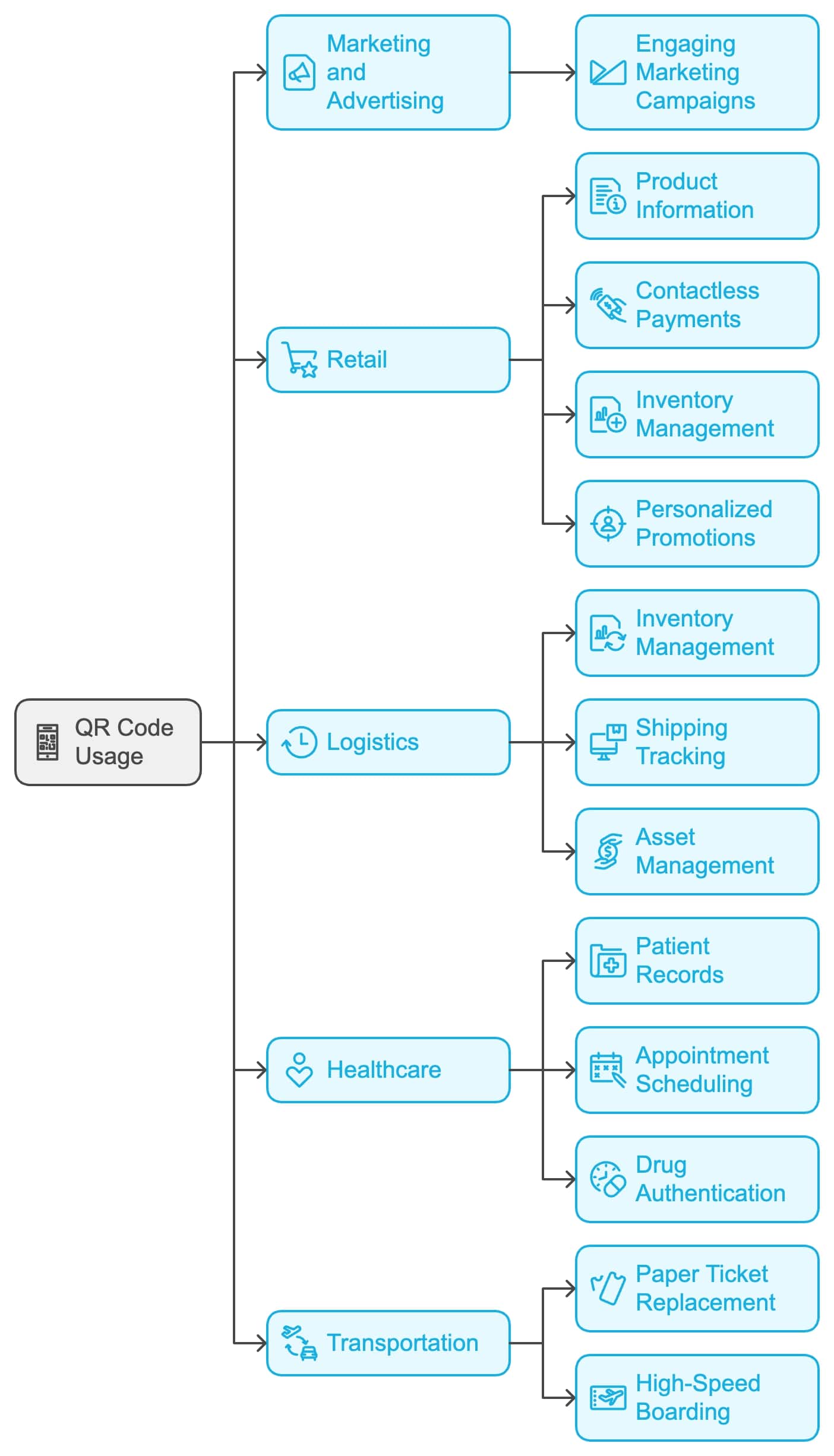
Global Trends in QR Code Adoption
QR codes have seen widespread adoption across the globe. Notably, certain countries have reported substantial QR code scanning activities due to various reasons, ranging from technological proficiency to pandemic-induced necessity.
United States
The United States leads the pack, accounting for a staggering 43.96% of the world's QR code scans.These scans are predominantly used for connecting users to URL, File, and vCard QR codes, offering customer experiences and productivity solutions across several sectors.
📊 Stats Alert: The number of consumers in the United States who scan a QR code with their smartphone is expected to grow by million between 2022 and 2025.
India
With 9.33% of global QR code scans, India has also seen a surge in QR code usage. The Indian government's push for cashless transactions with initiatives like BharatQR have significantly driven the increase in QR code usage.
France
France, with 4.0% of the global QR code scans, has seen a remarkable increase in QR code usage within tourism, government services, and transportation sectors.
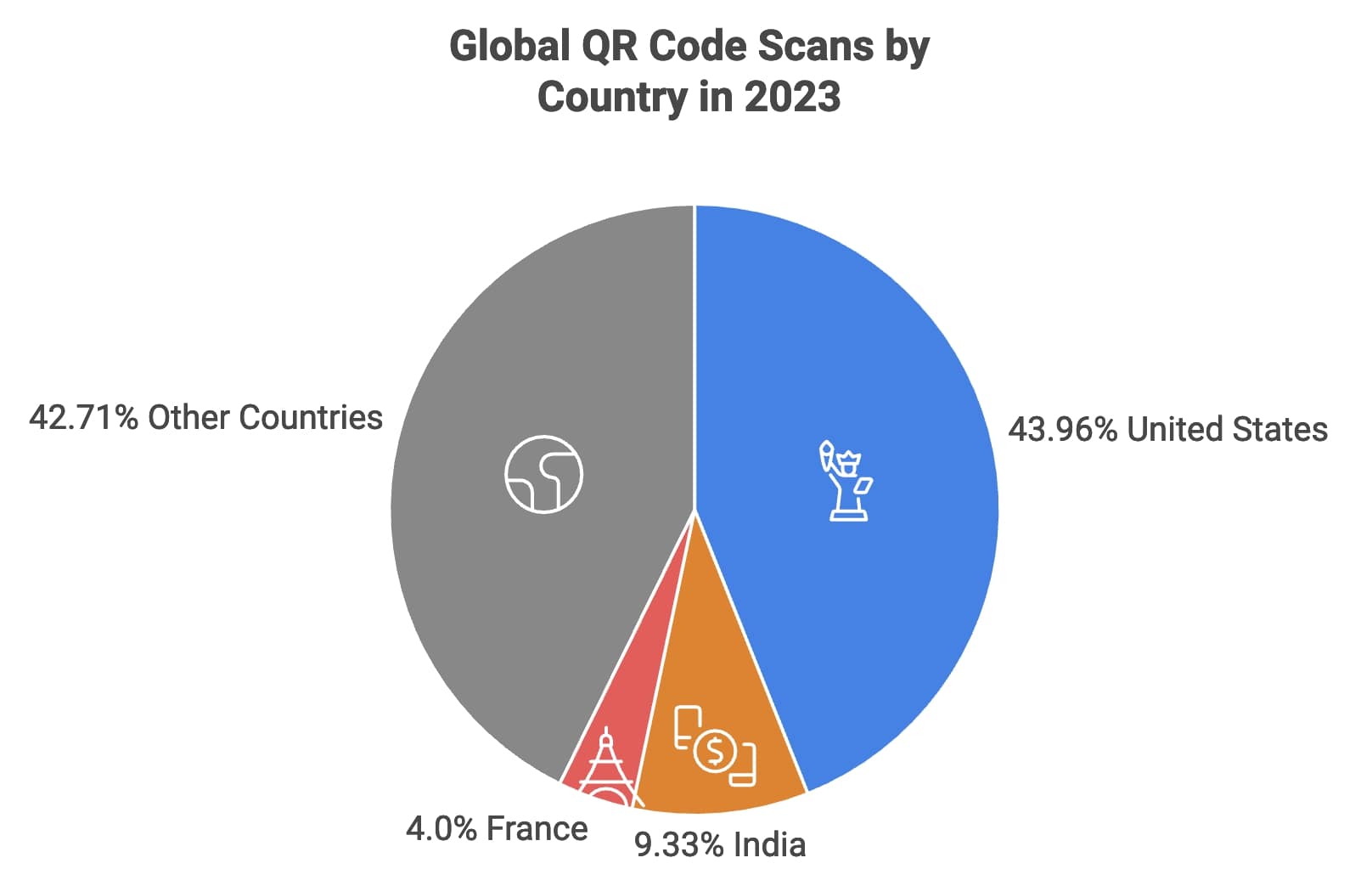
Innovative Applications of QR Codes
Many global brands are integrating QR codes into their operations and strategies to create seamless user experiences, improve brand communication, and enhance operational efficiencies. Here are some noteworthy examples:
Starbucks
Starbucks integrated QR codes for contactless ordering and payments, enabling customers to order without touching physical menus or transaction terminals. This initiative contributed significantly to the 50% growth in QR code usage in 2023, accounting for 50% of Starbucks transactions in the US alone.
PepsiCo
PepsiCo combined QR codes with augmented reality (AR) for their Super Bowl Halftime Show sponsorship. Scanning a QR code from Pepsi cans transported users into an immersive AR experience via the brand's app, resulting in a 20% uptick in engagement compared to traditional campaigns in the same period.
Amazon
E-commerce giant, Amazon, uses QR codes to provide product information and reviews directly to customers. In 2023, QR codes drove an increase of 15% in product page views, underscoring their effectiveness in boosting traffic and engagement.
McDonald's
Quick-service restaurant McDonald's adopted QR codes to improve their table services and loyalty rewards. This integration led to a 10% uptick in customer satisfaction scores in the previous year.
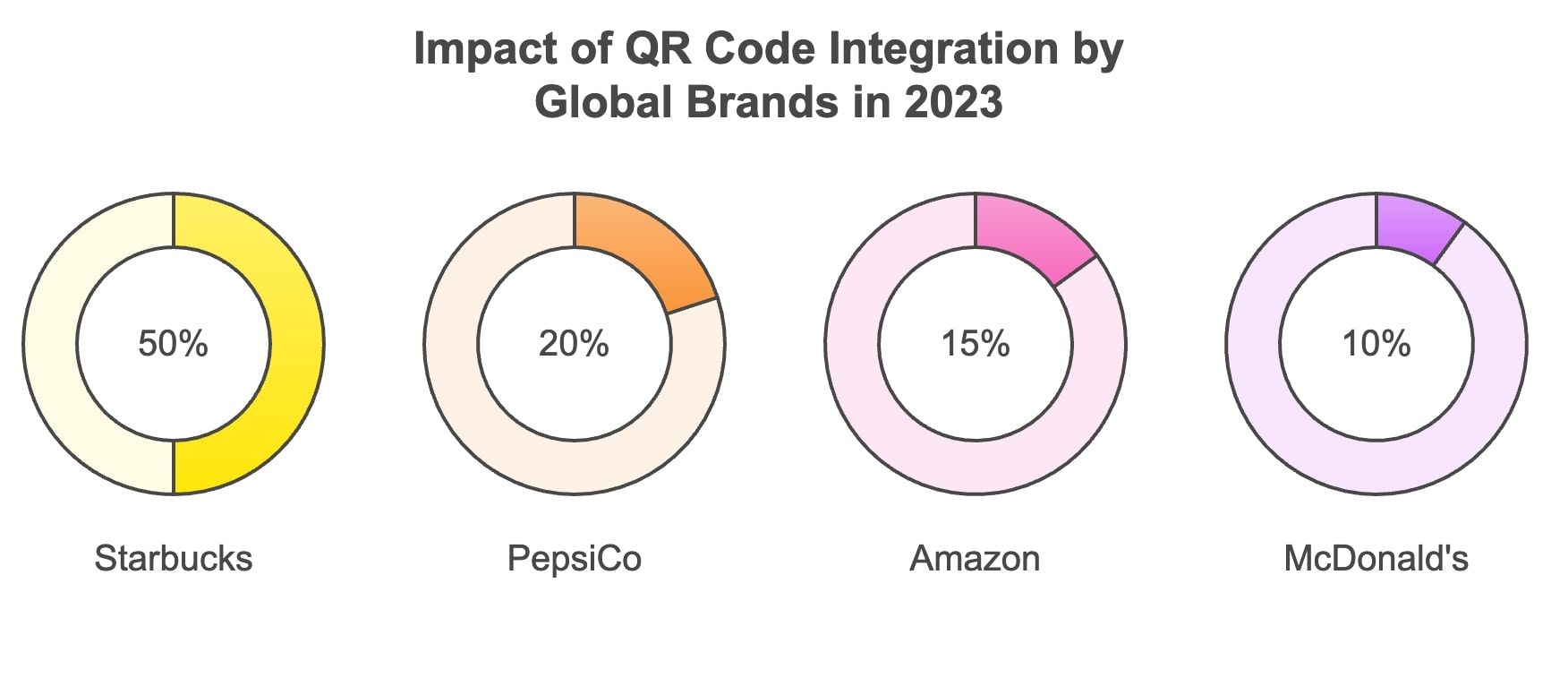
To build on these, let's look at updated 2025 case studies that highlight emerging innovations.
Updated Case Studies for 2025
In the pharmaceutical industry, QR codes are revolutionizing HCP engagement and patient education. For instance, pharma companies are using QR codes on packaging for instant access to drug information, clinical trials, and compliance tools, improving adherence rates by up to 30%.
Another example is in e-commerce, where brands like Nike continue to use QR codes on packaging for sustainability info, enhancing transparency and driving a 25% increase in customer loyalty.
Benefits of QR Code Integration
The increasing prevalence of QR codes across the globe can be attributed to the multitude of benefits that these little squares of code offer. Here's how:
Versatility
The application range of QR codes spans from providing pertinent product information, initiating smartphone functions, connecting users to the digital space, to even sharing multimedia files. This inherent adaptability makes QR codes valuable across different sectors.
Convenience
QR codes offer a simple way for businesses and customers alike to attain swift access to information or to complete transactions. Whether it's for connecting customers to a website via URL codes or facilitating swift payment processes, QR codes simply require a scan to serve their purpose.
Touch-Free Access
In the new normal where contactless interactions are preferred, QR codes have emerged as a safe bet for many businesses. QR codes are instrumental for touch-free transactions, reducing physical exchange of cash or cards, thereby providing a secure and convenient mode of transaction.
Cost-Effectiveness
The low cost of implementing QR codes makes them a budget-friendly tool for businesses of all sizes. In spite of being cost-effective, the potential of capturing an array of customer interaction data makes them a worthy investment for businesses aiming to enhance customer experiences.
Projections for QR Code Use in 2025
It's expected that QR codes will continue to grow in popularity and practical application into the foreseeable future. Let's delve into some predictions and trends projected for 2025:
Proliferation of Mobile Payments:
Mobile payments are on track to exceed $2.7 trillion globally by 2025, with QR codes playing a key role in this growth. The simplicity, convenience, and enhanced security offered by QR codes have made them a preferred method for facilitating mobile payments.
📊 Stats Alert: The global QR code payment market will grow from USD 15.95 billion in 2025 to USD 73.44 billion by 2035 at a CAGR of 16.5%.
Integration with Emerging Technologies:
QR codes are projected to amalgamate further with emerging technologies, like Augmented Reality (AR), offering more interactive and immersive user experiences.
Revolutionizing Retail:
In the retail sector, QR codes are predicted to become more integral to shopping experiences. Whether it's for providing additional product information, facilitating payments, or giving access to personalized promotions, QR codes are all set to transform the retail landscape.
QR Code Statistics:
Predictions suggest that the number of US consumers who scan a QR code with their smartphone will rise to over 100 million by 2025. Such an uptake points towards the pervasiveness of QR code technology and its influence in the digital world.
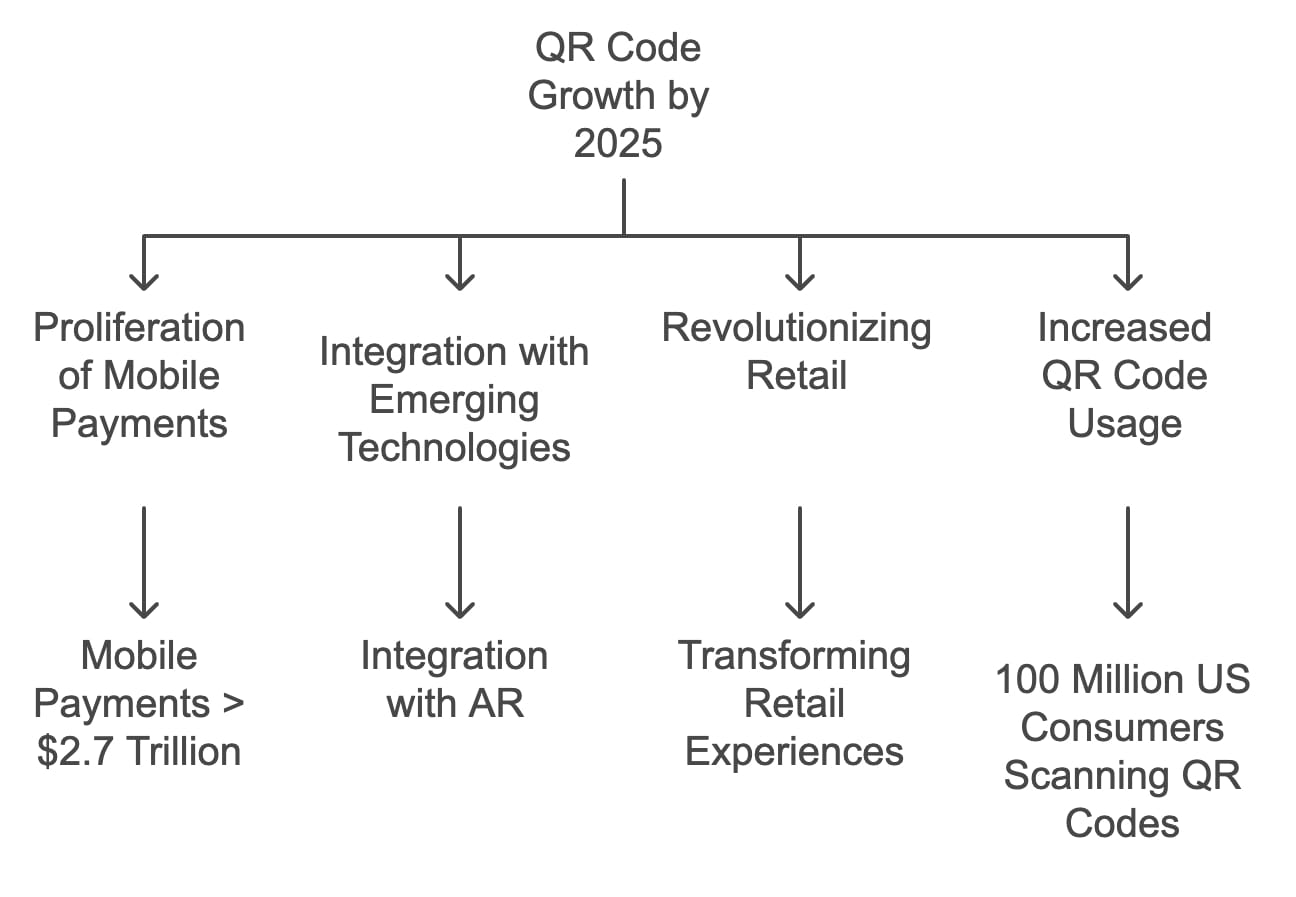
Potential Concerns and Drawbacks
While QR codes offer numerous benefits and open up new avenues of interaction and transaction, they're not without potential issues. Let's discuss a few challenges that might emerge with increased QR code adoption.
Security Issues
As with any technology interfacing with sensitive information, security is an inherent concern. QR codes, especially those related to payments and personal data, could be vulnerable to manipulation or fraud. Ensuring secure QR code generation and scanning practices is vital.
Privacy Concerns
The large amount of user data that can be collected through QR codes can raise privacy concerns. It's important for businesses to adopt data protection measures and comply with data privacy laws to protect consumer information[2].
User Experience Challenges
While QR codes are ultimately user-friendly, some individuals may find the process of scanning QR codes or downloading a scanner app cumbersome. Therefore, continuous efforts to simplify and improve the user experience are essential for wider acceptance.
Best Practices for Secure QR Code Implementation
To address these concerns head-on, here are some best practices I've developed from years of consulting on QR integrations:
Use Dynamic QR Codes: These allow for updates without changing the code, reducing risks from outdated links.
Implement Encryption: For sensitive data, encrypt the linked content and use HTTPS.
Educate Users: Provide clear instructions and warnings about verifying sources before scanning.
Monitor Scans: Use analytics to detect unusual patterns that might indicate fraud.
📊 Stats Alert: By 2025, global expenditures via QR code payments will be projected to exceed $3 trillion, a substantial rise from $2.4 trillion in 2022.
Conclusion
QR codes, a transformative element in the digital age, have reformed the way we connect, communicate and transact. They have permeated a multitude of industries and continue to evolve, engendering an array of use-cases that are practical, engaging, and convenient.
From facilitating an immersive advertising experience through to expediting mobile payments, QR Codes have exhibited immense flexibility and adaptability. And while some concerns and drawbacks do exist, the trajectory of QR code usage remains undeniably upward, promising an exciting future for this innovative technology.
Considering their current prevalence and given the predicted trends for 2025, it's clear: businesses that haven't adopted QR codes should consider doing so to stay competitive and relevant in the ever-evolving digital landscape.
As I've witnessed in my career, early adopters often see the highest ROI—don't get left behind.
Frequently Asked Questions
What are QR Codes?
QR Codes, or Quick Response Codes, are two-dimensional codes that can be scanned using a smartphone camera. These codes are used to store a variety of data types and are widely used for various applications across different industries.
How have QR Codes evolved over the years?
QR codes have significantly evolved since their inception in 1994. Initially used in the automotive manufacturing industry to track parts, QR codes are now used in various industries like marketing, retail, healthcare, transportation, and more, thanks to their adaptability and versatility.
Which sectors utilize QR codes the most?
QR codes are extensively used across numerous sectors. The leading sectors utilizing QR codes include marketing, retail, logistics, healthcare, and transportation. In these sectors, QR codes enhance customer engagement, streamline operations, and offer effective solutions for diverse needs.
What is the projected growth of QR code usage?
QR code usage has seen exponential growth in recent years, and predictions indicate that this upward trend will continue into the future. By 2025, the number of U.S. consumers scanning a QR code is expected to rise to over 100 million.
Are there any security or privacy concerns related to QR codes?
As with any technology dealing with personal data or transactions, there are potential security and privacy concerns. It's crucial to use secure QR code generation and scanning practices to protect against potential fraud or manipulation. Likewise, businesses should ensure they comply with data privacy regulations when handling customer data collected through QR codes.
How are global giants using QR codes?
Many leading companies are integrating QR codes into their operations and offerings. For instance, Starbucks uses them for contactless ordering and payments, PepsiCo combined QR codes with AR for their Super Bowl Halftime Show sponsorship, Amazon provides product information and reviews through QR codes, and McDonald's has enhanced their table service and loyalty rewards with the help of QR codes.

